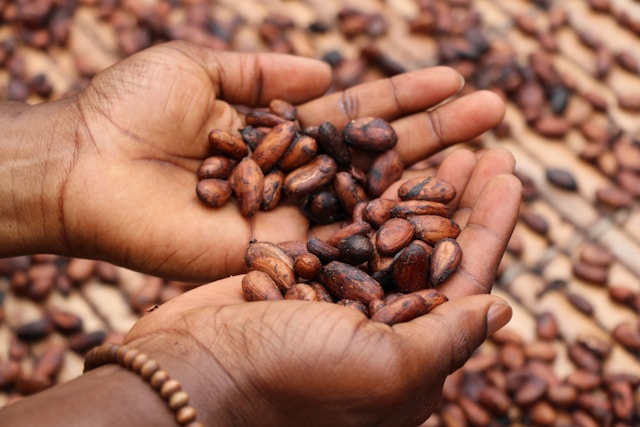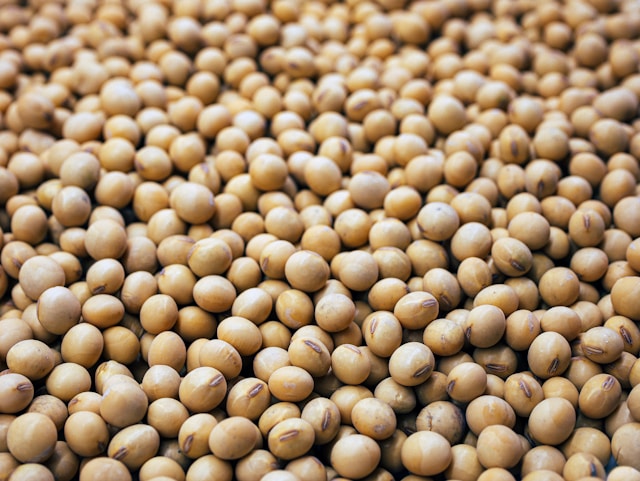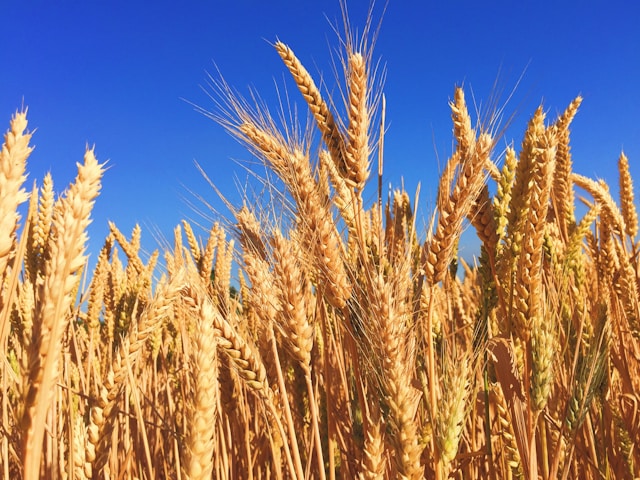The exciting world of trading isn't limited to forex, stocks, and precious metals. There are several other commodities available that offer unique trading opportunities. Meet the soft commodities.
Whether it's your morning coffee or the sweetener in your afternoon treat, soft commodities are everyday goods that fuel the global economy and, potentially, your portfolio too.
So, with that in mind, let’s reveal nine lesser-known soft commodities that can help diversify, and grow, your portfolio.
Soft commodities you can trade
1. Cocoa Beans

Referred to as 'brown gold', cocoa beans are the foundational ingredient behind one of the world's most beloved indulgences - chocolate. These beans are not just a staple of your favourite sweet treats but also represent a significant commodity in the global market.
The dynamics of the cocoa market are complex, subject to a variety of factors like consumer demand, currency exchange rates, and even the weather!
As a main player in the world's cocoa production, the climate in West Africa directly impacts the yield of cocoa crops, making it a critical factor for market prices.
Additionally, cocoa's status as a commodity traded on international markets means that fluctuations in currency values have a significant impact on its price. Transactions involving cocoa are primarily conducted in US dollars. When the value of the dollar strengthens, cocoa becomes more expensive for buyers using other currencies, which can decrease demand and affect global prices - and vice versa. The price of the euro and the British pound are also influential, given Europe's significant role in the consumption and processing of cocoa.
Finally, consumer demand also has a notable impact on the cocoa market, particularly during peak times such as holidays and special occasions when the demand for chocolate surges. These periods can lead to spikes in cocoa prices as manufacturers stock up on cocoa beans to meet consumer needs.
Traders must keep an eye on both the weather and social conditions in the main cocoa-producing countries. By monitoring these factors, they can make informed predictions about potential price movements, giving them an edge in the market.
Did you know? 70% of the world's cocoa production comes from West Africa.
2. Coffee

For many, coffee is the fuel that propels the day. This caffeinated powerhouse is also an active soft commodity in the trading market, influenced by weather volatility, pest infestations, and currency fluctuations.
Coffee comes in two varieties - Arabica and Robusta - each with its own market dynamics.
Arabica beans typically enjoy premium prices due to a 'superior flavour profile'. The Arabica market is heavily influenced by weather conditions, as the plants grow best in mild climates with regular rainfall. Extreme weather events such as droughts or floods can significantly impact production and prices.
On the other hand, Robusta coffee is less sensitive to weather conditions and tends to be more resistant to pests. However, its demand is strongly tied to economic factors, with its primary use being in instant coffee production. As a result, global economic health and consumer spending habits can impact the price of Robusta coffee. Understanding Arabica and Robusta's unique dynamics is crucial to making informed trading decisions.
Did you know? Around 2.25 billion cups of coffee are consumed globally every day!
3. Cotton

Cotton is an essential part of the fashion industry, and trading in cotton can be just as dynamic. Its market is sensitive to various global factors, such as shifts in the Chinese economy, weather disruption, and, of course, demand for textiles in the global marketplace.
Cotton's market sensitivity to shifts in the Chinese economy arises from China's substantial influence on both the supply and demand sides of the global textile industry. As one of the largest consumers and producers of cotton, any change in China's economic conditions can lead to significant fluctuations in cotton prices worldwide.
Economic expansion or contractions in China affect its textile manufacturing industry's demand for raw cotton. Additionally, China's policies on cotton import and export can dramatically alter global supply, impacting prices further.
Cotton is also cyclical, meaning that its price often increases and decreases with the seasons, as it's a seasonal crop. It's affected by geopolitical issues too, such as trade wars that can impact import and export tariffs.
However, the most significant factor in cotton prices is demand. As the world's population continues to grow, so does the need for clothing and other textile products made from cotton. With this rise in demand comes the potential for trading opportunities for those keeping a close eye on market trends and willing to take calculated risks.
Did you know? The cotton plant is not just valuable for its fibres - the seeds help produce cottonseed oil (used in salad dressings and mayonnaise), while the stalks and leaves can be used as a natural fertiliser or animal feed.
4. Corn

Corn, also known as maize, is one of the most versatile crops around. Within the trading arena, it's influenced by everything from the rise of ethanol production (corn is a key feedstock) to the impact of severe weather on harvests, and even the dairy industry, as it's a primary feed for livestock.
The corn market is also sensitive to government policies and corn subsidies. Significant changes in these policies can impact corn prices, making it an exciting market for traders to watch.
The US is the top producer and exporter of corn, but it's a highly exchanged commodity across the globe. The demand for corn in emerging markets has grown exponentially, making it a hot commodity on the trading market.
With so many factors impacting corn prices, traders must keep a close eye on both macroeconomic trends and micro-level events to make sound trading decisions. Understanding the various factors that influence corn prices is essential to stay ahead in this market.
Did you know? About 15% of the world's corn production is used for non-food purposes - such as animal feed, biofuels, and industrial products like plastics and adhesives.
5. Soybeans

Soybeans are often associated with being a primary source of animal feed and oils used in food products but have also become a major player in biofuels. In the trading market, soybeans' price volatility is linked to weather conditions, particularly in the US Midwest, and trade tensions, given China's significant role in global soybean demand.
The connection between global politics and the soybean market is huge. Soybeans are grown in places that often get caught up in trade disputes, putting them right in the middle of big economic changes, especially between heavyweights like the US and China. Both these countries are major in the soybean game - they grow a lot, and they eat a lot, which means soybeans can become a hot topic during trade talks.
These disputes can shake up the market, affecting prices and making things either tricky or profitable for traders. So, if you're trading soybeans, keep an eye on what's happening in the world of politics. It's all part of the game to stay ahead in the ever-moving soybean market.
Did you know? The soybean plant is incredibly versatile. Beyond its use in animal feed and cooking oils, it's an important ingredient in a wide range of products, from biofuels to crayons.
Trade coffee, copper and more with FXTM
At FXTM, we offer our clients the opportunity to trade a variety of soft commodities, including cocoa, coffee, cotton, corn, soybeans, wheat, copper, sugar, and US heating oil.
With our user-friendly trading platforms and competitive pricing models, traders can easily access these markets and take advantage of their potential for profit.
Diversify your portfolio and start trading soft commodities with FXTM today!
Trading is risky.
6. Wheat

Wheat is a staple food worldwide, and as such, its trading market is profoundly influenced by global food policy, geopolitical tensions, and weather-related production factors.
In recent years, wheat prices have also been impacted by the growing trend of alternative grain production, such as corn and soybeans. As these crops become more popular for both food and biofuel use, they can disrupt traditional wheat markets.
Wheat is a bulky commodity to transport, so transportation costs play a significant role in wheat trading. Any changes to global shipping rates can have a weighty impact on prices.
It's essential for traders to stay updated on global policies and trends that can influence the wheat market, along with closely monitoring supply and demand factors. The variability in its pricing makes understanding the market's demand patterns and keeping a close eye on agricultural crop reports a necessity.
Did you know? Wheat is used in everything from bread and pasta to beer and biofuels, making it a vital commodity in both the food and energy industries.
7. Copper

Though not exactly a foodstuff, copper is the barometer of the global economy and a significant soft commodity, given its critical role in infrastructure and manufacturing.
As a key component in electronics and construction, copper sees trading volume due to industrial demand. Like other soft commodities, copper prices are heavily influenced by global events and policies.
Changes in production or demand from countries like China or the US can significantly impact prices. Additionally, currency fluctuations can also affect copper trading, as most contracts are denominated in US dollars.
Copper's indispensable role in a multitude of industries, from construction and automotive to renewable energy and electronics, means it has a consistent worldwide demand. This demand is closely tied to global economic health, making copper an attractive commodity for those looking to diversify their investment portfolio with a product that offers insight into economic trends.
The transition towards sustainable and green technologies, particularly in renewable energy and electric vehicles, is also expected to drive an even greater global demand for copper.
To stay ahead in the copper market, traders should monitor macroeconomic trends and anticipate how changes in global policies and events may impact demand for this versatile metal.
Did you know? Copper was one of the first metals used by humans, dating back to 8000 BC in the Middle East. And today, it's still one of the most widely used metals in the world.
8. Sugar

Sugar, as a sweet commodity, is tied closely to the food and beverage industry. It also plays a significant role in international trade, with Brazil being the top producer and exporter of sugar globally.
The sugar market is highly influenced by weather conditions, as it affects crop production, especially in major producing countries like Brazil and India. Other factors such as government policies, exchange rates, and global demand also impact sugar prices.
In recent years, there has been a growing trend towards alternative sweeteners, like high-fructose corn syrup, which has caused some fluctuations in the sugar market. However, with increasing global demand for processed and packaged foods, particularly in developing countries, the demand for sugar remains steady.
Sugar isn’t reserved for the sweetener market either. Young sugar canes have a low sucrose level, making them ideal for ethanol production, used to produce an alternative to traditional gasoline or fuel. Cane farmers will typically consider the prices of both sugar and ethanol before deciding how to split their crops. Over or under-production of either sugar or ethanol can cause supply issues and impact prices further.
Sugar trading is not just about supply and demand; it's also about international policies on subsidies and tariffs, ensuring a complex trading environment ripe for opportunities.
Did you know? The average American consumes over 126 grams of sugar per day, almost double the recommended daily intake by the World Health Organization.
9. US Heating Oil

Lastly, a commodity you may not be quite so familiar with is US heating oil (or USAHO).
US heating oil, as its name suggests, is a vital component of keeping many homes warm through winter. As such, it's directly linked to seasonal shifts, especially in the Northeast of the US, where demand soars in the colder months.
Like many soft commodities, supply and demand dynamics are influenced by global production levels, and political climates. In the case of heating oil, the efficiency of homes and advances in heating technologies play a significant role in price movements for traders.
The link between heating oil and crude oil markets also adds an additional layer of complexity for traders to consider.
For those looking to diversify their portfolio with a commodity that's closely linked to seasonal trends and energy consumption, US Heating Oil may be a suitable option.
Did you know? The United States is the world's largest consumer of heating oil, accounting for approximately 20% of global consumption.
Why trade soft commodities?
Traders might find trading soft commodities particularly attractive for several reasons, including:
-
Diversification of their portfolios.
-
Hedging opportunities against inflation or currency depreciation.
-
Potentially profitable opportunities through price volatility.
Diversifying into soft commodities allows traders to mitigate risk since these markets often move differently than traditional financial markets like stocks and metals.
By investing in soft commodities, traders can protect themselves against fluctuations in other parts of their portfolio, leveraging the unique dynamics of commodities such as coffee, cotton, and sugar to anticipate and counterbalance potential losses elsewhere.
The bottom line
In the vast world of global markets, soft commodities stand out. They blend essentials with our indulgences, but their prices can be volatile. And while volatility brings with it opportunities for potential profit, careful risk management should be in place to mitigate any possible losses.
To succeed, you need to monitor everything from price trends to global events. From wheat and copper to sugar and US heating oil, each commodity tells a story about demand, technological advances, and environmental efforts.
For those looking to diversify their portfolio, soft commodities are an intriguing option. Stay alert, be flexible with your strategy, and heed the market's signals to navigate their volatility successfully.